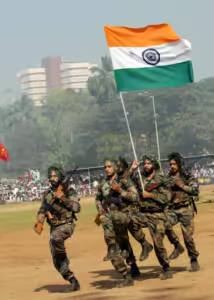Zorawar, light combat tank, tested in Gujarat’s Hazira on Saturday by Defense Research and Development Organization (DRDO). DRDO chief Samir V Kamath stated that this light battle tank is expected to be incorporated into the Indian Army in high-altitude areas in eastern Ladakh in 2027 under ‘Project Zorawar’ to bolster its overall firepower and operational prowess to deal with any eventuality, following all trials.

DRDO chief Dr Samir V Kamath said, “It’s indeed a momentous day for all of us to see the light tank in action. It makes me happy and proud.

He reviewed the project’s progress at the Larsen and Toubro facility in Hajira, Gujarat.
The DRDO and L&T have integrated USVs with loitering munitions in tanks, drawing experiences from the Russia-Ukraine conflict.
Everything You Need to Know About light weight Tank:

- These tanks, to be bought under ‘Project Zorawar’ — named after legendary Zorawar Singh, a military general who served under Raja Gulab Singh of Jammu — will be as powerful as the current ones.
- The tank is expected to be deployed into the Indian Army by 2027 following complete trials.
- This light tank developed by DRDO and Larsen & Toubro, is designed to address the Indian Army’s needs in eastern Ladakh against Chinese deployment over the Line of Actual Control.
- The tank’s lightweight and amphibious features allow it to drive through difficult mountain slopes and cross rivers and other bodies of water considerably more easily than the heavier T-72 and T-90 tanks.
- Dr. Samir V Kamath, chief of DRDO, examined the tank project for the Indian Army in Hazira, Gujarat. T
- he tanks’ missile-firing capacity, counter-drone equipment, warning system, and power-to-weight ratio make them “very agile”.
How does Zorawar perform in extreme weather conditions?

- The Zorawar LT is specifically designed for high-altitude warfare in challenging terrains like the Himalayas.
- In extreme high altitudes like Ladakh, operating main battle tanks (MBTs) becomes difficult due to rarefied air, lack of oxygen, and other logistical challenges.
- The tank addresses this by being lightweight, maneuverable, and suitable for harsh conditions.
- The light combat tank LT’s 25-tonne mass contributes to its agility and cross-country mobility.
Light tanks serve important roles in modern military operations:

- Tactical Mobility:
- Light tanks are designed for rapid movements in and out of combat.
- They can outmaneuver heavier tanks due to their smaller size, thinner armor, and lighter weight.
- Role in Expeditionary Forces:
- Light tanks are primarily employed for:
- Screening: Gathering intelligence and detecting enemy movements.
- Armored Reconnaissance: Scouting and assessing terrain.
- Skirmishing: Engaging in small-scale combat.
- Artillery Observation: Aiding artillery units.
- Fire Support: Providing backup in landing operations.
- They complement larger tanks where heavy tanks are unavailable or face operational challenges.
- Light tanks are primarily employed for:
- Urban Warfare:
- Light tanks are crucial in urban environments.
- They offer lethal firepower to engage enemy armored vehicles while minimizing collateral damage.
- The ability to be airlifted and maneuver in close-quarters terrain is essential.
The Indian Army has a strong tank fleet, with a mix of indigenous and foreign designs. The Indian Army operates a variety of light battle tanks, especially for reconnaissance, ambush, and quick deployment operations. Key examples include the T-72M1 Ajeya, an enhanced derivative of the Soviet-made T-72, and the T-90 Bhim, an upgraded version of the Russian T-90.

The Indian Army uses the Arjun tank, which was designed and constructed in India. These tanks are recognized for their adaptability, agility, and firepower, making them useful in a variety of terrains and combat situations.










